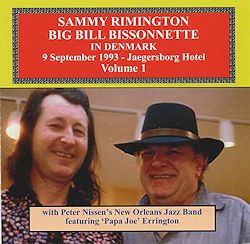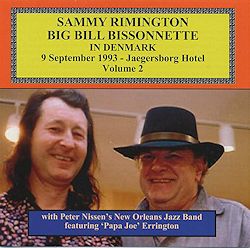 BUY NOW AmazonUK AmazonUS |
SAMMY RIMINGTON & BIG BILL BISSONNETTE
In Denmark 1993 Volume 1
|

BUY NOW AmazonUK AmazonUS |
SAMMY RIMINGTON & BIG BILL BISSONNETTE
In Denmark 1993 Vol 2
|
Vol. 1
1. Bogalusa Strut
2. Darkness on the Delta
3. Lord, Lord, Lord
4. After You’ve Gone
5. Should I?
6. Rose Room
7. Just a Little While to Stay Here
8. Somebody Stole My Gal
9. The World Is Waiting for the Sunrise
Vol. 2
1. St. Louis Blues
2. When My Dreamboat Comes Home
3. Ice Cream
4. Papa Joe’s Davenport Blues
5. In the Shade of the Old Apple Tree
6. I’m Alone Because I Love You
7. C-Jam Blues
8. Honeysuckle Rose
Big Bill Bissonnette – Trombone, vocals (vol. 1 track 8; vol. 2 tracks 1 & 5)
Sammy Rimington – Clarinet, alto sax
Papa Joe Errington – Trumpet
Peter Nissen – Drums, leader
Leif Madsen – Clarinet, alto sax
Torben Kjaer – Piano
Henrik Stiigvad – Banjo, guitar
Holden Fogh – String bass
Recorded at the Jagersborg Hotel, Jagersborg, Denmark on Sep. 9, 1993.
When a performance is recorded on location rather than in a studio, certain hazards with the sound quality loom, and they are not completely mitigated here. No information is given in the CD booklet about the sound recording provisions, and I would guess that the musicians were not individually miked. Thus on some tracks the bass is over-recorded, and on others one must strain a little to hear the trumpet. There is lack of balance and separation on many tracks, seeming to indicate there was either no or insufficient mixing. The result, unfortunately, is a good concert not receiving the quality of recording it deserved.
The band on these discs, Peter Nissen’s New Orleans Jazz Band, is another of those first rate bands out of Europe, in this case Denmark. It is not, however, what I would classify as a New Orleans band, despite its name, as there is no emphasis on ensemble work and there is a good deal on soloing. It might be termed a good Dixieland band. The musicians all have something to say and have the opportunity here to do so, although occasionally one must lean in to hear it.
Papa Joe Errington’s trumpet playing, as Bissonnette says in the CD booklet, clearly shows Erringon to be a disciple of Louis Armstrong. The breaks he takes in After You’ve Gone (v. 1 #4), the opening cadenza on Papa Joe’s Davenport Blues (v. 2 #4), both suggest Armstrong, and while the coda on this latter tune is Beiderbecke-like, the rest of the rendition is in the Armstrong vein. Errington’s solos on most of the other tracks, where he delights in exploring the upper register, executing small runs, and indulging fast tonguing, all also illustrate the Armstrong influence.
The two reed players, Sammy Rimington and Leif Madsen, are in fine form. They tend not to play the same instrument on a track but one plays clarinet and the other alto sax, neither being identified as to horn. Each has technique to spare, and they revel in all registers. Bissonnette’s trombone playing is adequate, but I am not a fan of his singing.
The rhythm section is solid—no rushing, no dragging. Henrik Stiigvad, banjo and guitar, as well as keeping flawless time expertly handles the solo over the stop time of the rest of the group on the banjo players’ anthem: The World Is Waiting for the Sunrise (v. 1 #9). Holden Fogh on string bass works in concert with Stiigvad and Torben Kjaer on piano to provide a solid bottom for the front line. Kjaer is given a turn in the spotlight being featured on C-Jam Blues (v. 2 #7), keeping a piano boogie left hand going behind all of the other instruments as they solo in turn. This track is a bit too long—interest dwindles—and could have profited by having fewer choruses from each soloist. Lastly, leader Peter Nissen’s drumming throughout is unobtrusive, his bass drum accents suggesting the classic New Orleans drummers.
The band here, with Bissonnette substituting for its regular trombone player and Rimington as an additional reed, plays some exciting jazz, particularly when playing as an ensemble, especially on the choruses going out where the level of excitement rises perceptibly and the audience picks up on it, showing their approval with the rhythmic hand clapping so beloved of the European audiences.
Standout tracks for me were When My Dreamboat Comes Home (v.2 #2) and Papa Joe’s Davenport Blues (v. 2 #4). The former starts with the trombone stating the melody and the clarinet providing counterpoint, accompanied by the rhythm section, at a slow, relaxed tempo that is maintained all through. They are joined then by the trumpet, and after solos they begin the outchoruses with a crescendo of feeling, Errington reaching for his highest notes, sweeping the rest of the group—and the audience—with him.
The other commanding track, Papa Joe’s Davenport Blues, is the trumpet feature in this set, where Errington states the melody, but with some small improvisations around the edges. He stays in the mid to lower registers, with quick fingering and the occasional growl, and the entire track is given to him and Kjaer on piano. As I said earlier, this interpretation is from the Armstrong perspective, not the Beiderbecke one, except for the coda ritard, which is a nod to the composer, Bix.
So there it is—some very good jazz that could have been better recorded. However, all things considered, these two CDs are worth having, and Upbeat is to be applauded for reissuing them, keeping them available in its Jazz Crusade catalog.
Jazz Crusade CDs are available on the Upbeat web site www.upbeat.co.uk as well as from on-line sites such as Amazon.ere
Bert Thompson